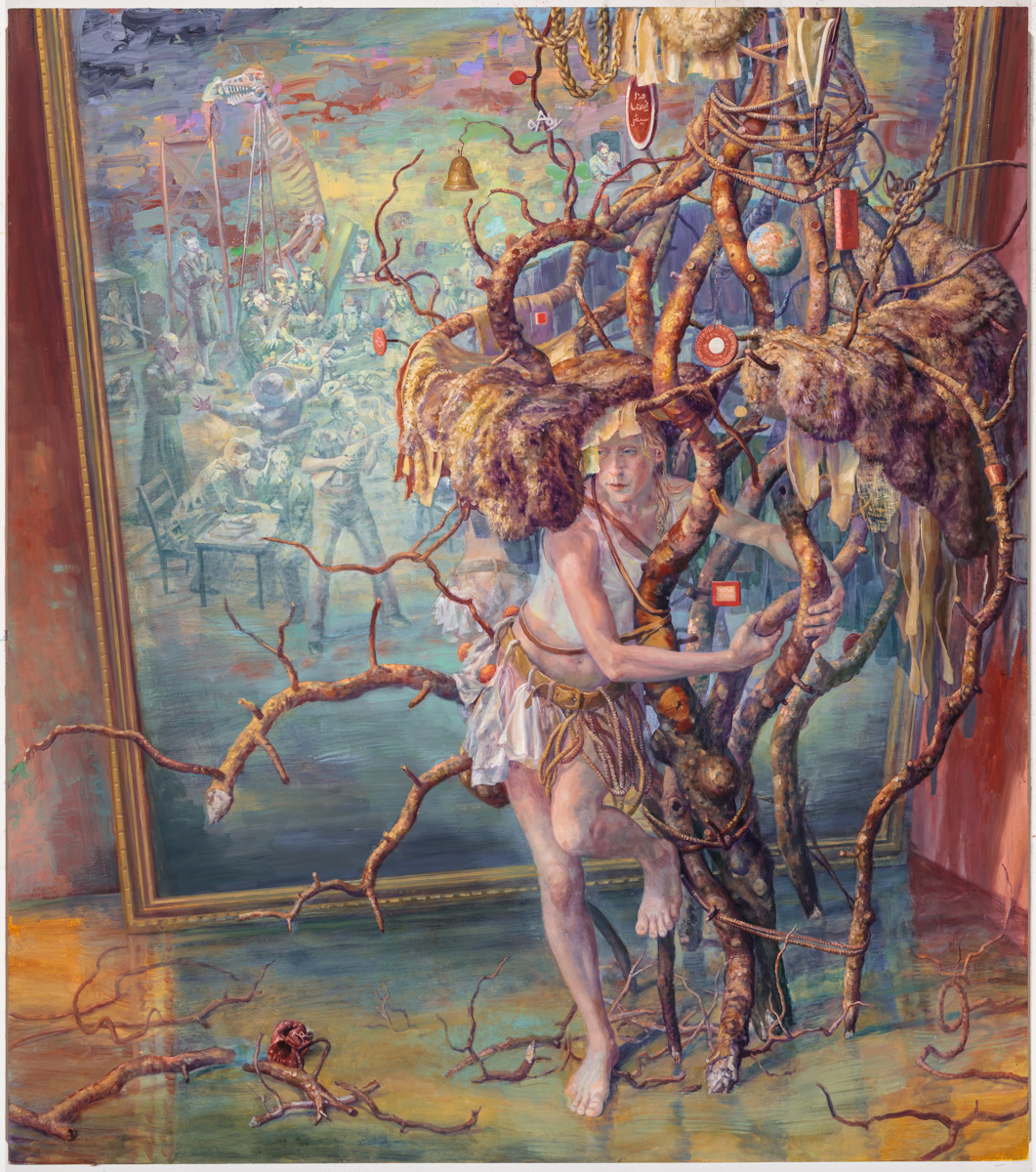Whitehot Magazine
October 2025
"The Best Art In The World"
"The Best Art In The World"
October 2025
Julie Heffernan: Pre-Occupations
 Julie Heffernan, Self-Portrait as Wrangler II, 69 x 66 inches
Julie Heffernan, Self-Portrait as Wrangler II, 69 x 66 inches
Julie Heffernan: Pre-Occupations
Mark Moore Gallery
May 7 - June 13, 2015
By MEGAN ABRAHAMS, JUN. 2015
Dramatic, intense, surreal and rich with metaphor, Julie Heffernan’s recent series of large figurative tableaux transport us to an apparently post-apocalyptic place and time conceived from the artist’s imagination. In her elegantly realized, often disturbing vision, the earth’s environment appears to have deteriorated, propelling humanity back to a more rustic, primitive and desperate way of life. Layered with beauty, conflict and tension, there is much at stake in the world as portrayed by Heffernan. Her overriding concern is the man-made destruction wrought by climate change, overpopulation and ecological imbalance, which she articulates in the tradition of historical narrative painting interwoven with her own surreal vernacular and elements of the Baroque.
The large scale of these works, their deep and mysterious perspective, as well as a powerful and gripping narrative thread, pull the viewer in. Filled with elaborate detail and symbolism, the paintings are theatrical, like stage sets. In three of the works, the artist has contrived the intriguing device of depicting a painting inside the painting -- seen in the backgrounds behind the primary subjects. In Self Portrait as a Wrangler II (2015, oil on canvas, 68 x 66 inches). Self Portrait with Tree (2015, oil on canvas, 68 x 60 inches), and Self Portrait Gathering Christmas Tree (2015, oil on canvas, 68 x 66 inches) the female figures are positioned in the foregrounds, while the backgrounds are rendered in subdued shadowy blues, partly hidden from the light, the substance of memory or dreams.
The juxtaposition of one dramatic narrative on top of another may imply two different time-frames, the present-day drama in the foreground, and past events in the background, driving the current narrative. On another level, the paintings are also a series of self-portraits in which the artist portrays herself as the protagonist in a mysterious dystopia. In this world, her figure -- a heroic vigilante -- appears to have set out to rescue the vestiges of earth’s threatened natural habitat. The female figure is often portrayed holding a tree, as if locked in an embrace with this revered symbol of nature. In Self Portrait with Tree, her figure and the tree are entwined, as if wedded into a single entity. Her imagery is also filled with striking contrasts. While dim shadows pervade the recesses of the building in the background, and tiny models of classic architectural structures topple from the tree branches, an almost pre-Raphaelite golden glow bathes the figure grasping the fallen tree with its growth of thick foliage and lush apples in the foreground.
 Julie Heffernan, Self-Portrait Fixing My Foot, 67 x 70 inches
Julie Heffernan, Self-Portrait Fixing My Foot, 67 x 70 inches
Beyond the more subtle inferences of scenes where figures are apparently working to repair or salvage something from the wreckage, Heffernan has left more literal clues -- including actual signs with legible text embedded into her compositions. In Self-Portrait as a Wrangler II, the figure in the foreground is clothed merely in a white vest and a sort of makeshift utility belt hung with white rags and coiled ropes. She grasps the tree as if rescuing or purloining it. Hanging from its branches are objects such as a globe and discs, one of which is inscribed, “The sun shone having no alternative.” In the background is a gold-framed painting, leaning at an angle, suggesting a museum installation in the process of being dismantled. The painting depicts a further narrative in its series of composite vignettes depicting historical topics like war and even dinosaurs, connoting the history of life on earth.
Heffernan succeeds in alerting us to the gravity of the impending environmental scenario. Whether she intends to convey a somewhat pessimistic point of view, or to offer the prospect of hope, is less clear. As the primary actor in this drama, the artist herself appears as both an ordinary human being grappling with a troubled world, and a sort of goddess-like creature with extraordinary power and determination. In Self Portrait Fixing My Foot (2015, oil on canvas, 67 x 70 inches), her figure is portrayed in a strange large-scale landscape flooded with sunlight. On a superficial level, this is a domestic scene. In the foreground, the figure is seated on a rock, bandaging her foot. On a deeper level, it appears she is trying to preserve aspects of a threatened civilization. The painting presents numerous unanswered questions: What happened to her foot? Why is she in a rustic home in the forest? Why are certain books stacked on makeshift shelves in the middle of the woods? What is the significance of the row of shrunken heads, still emoting, their features filled with expression, displayed on the ledge nearby? What is happening in the incongruous scene in the background in which smaller figures appear to be embroiled in conflict?
While some of the works reference interiors and architectural details, often partially collapsed or entirely in ruins, other compositions are in landscape settings, or often a combination of the two. Yet ultimately, Heffernan’s paintings are a reverential homage to the natural world, and may be thought of as descending from the work of 19th century Hudson River School painters like Thomas Cole and Albert Bierstadt who embraced and idealized the American landscape -- and whose theories Heffernan acknowledges played a role in shaping her sensibilities. The impetus animating Heffernan’s carefully orchestrated world brings to mind the paintings of Irene Hardwicke Olivieri, another contemporary American female painter who has taken on the environment as her focus, and who also uses self-portraiture in her narrative symbolism.
Perhaps intended to both inspire and shock the viewer into action, Heffernan’s paintings deftly combine elements of lush beauty -- glowing light, a profusion of flowers and fruit on trees -- with more gruesome imagery, such as a pile of dead stags and scenes of violent political or religious persecution. Heffernan addresses the earth’s environmental and social degradation through a profound visual activism that compels and challenges us to look more closely – both at the paintings and real world events that have played a role in catalyzing their creation. As the artist states, this work is about accepting responsibility for the consequences of our own actions, and “perhaps an opportunity for some creativity in how we approach habitats and lifestyles. No more room for wastefulness, but what do we decide to keep and what to get rid of? The figures are now engaged in work of some sort: pulling, dragging, wrestling with materials in order to start the work of change."
 Julie Heffernan, Self-Portrait Gathering Christmas Tree, 68 x 66
Julie Heffernan, Self-Portrait Gathering Christmas Tree, 68 x 66
 Julie Heffernan, Self-Portrait with Tree, 68 x 60
Julie Heffernan, Self-Portrait with Tree, 68 x 60

Megan Abrahams
Megan Abrahams is a Los Angeles-based writer and artist. The managing editor of Fabrik Magazine, she is also a contributing art critic for Art Ltd., Fabrik, ArtPulse and Whitehot magazines. Megan attended art school in Canada and France. She is currently writing her first novel and working on a new series of paintings.

view all articles from this author









